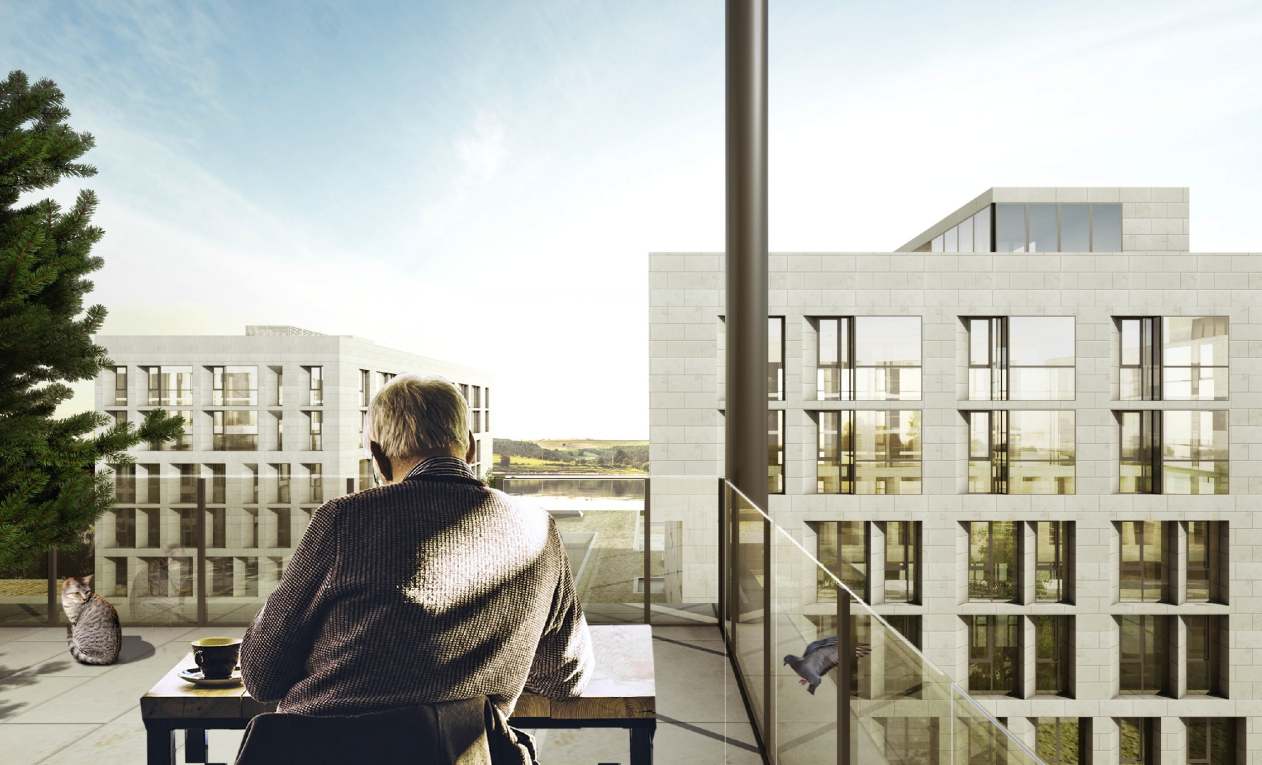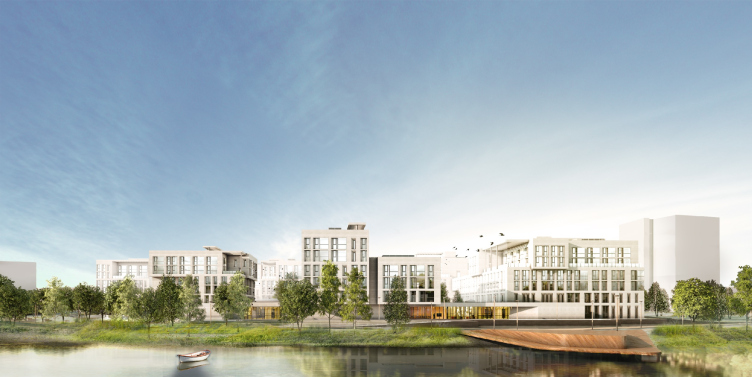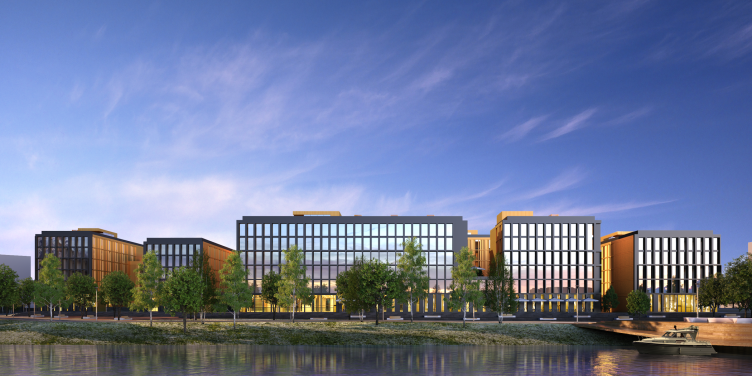“Yesterday’s college students”, as they describe themselves, Yegor Obvincev and Vladislav Sarapulov, are sharing about the first project that they did independently for the company, and about the experience of going through all of the project stages, from context analysis to developing a marketing strategy for the new complex, as well as about getting a better knowledge of their own selves.
Under the contractual conditions, the architects cannot disclose the location of the complex; let’s just say for the time being that it is business class apartments. The land site is quite an obliging one, located in the middle of a large city. Next to it, there is a lake, whose waterfront has recently begun to get landscaped. The mirror surface of the water impartially reflects the historical buildings, the Soviet-time construction, and the modern ones too.
The architects wanted to create a nice and quiet place with cozy little yards and a green garden, at the same time endowing it with an identity easily recognizable by its clear-cut silhouette, making it a landmark of the circumferential waterfront, and keeping a feel of an accessible and friendly public place. In the course of work, the architects understood a few important things.
An architect must be an actor and a psychologist. The architect’s first task is to understand his client. And he must do that not so much by asking direct questions, as intuitively, through creating a rapport with the client, replacing his self-evident politeness with genuine interest. And, in order to do that, he must learn how to live through someone else’s experience, very much like an actor who acts in accordance with the Stanislavsky system, which, it must be said, is quite a challenge for yesterday’s college students who are now designing a high-end housing project. However, the architects define this ability as the most important one, even more important than then conventional drawing skills.
Yegor also believes that an architect must be a bit of a psychologist because it is his job to help the client form the bullet points, the imagery, and the character of the project. These bullet points are also affected by the context: the culture, the nature, and the national peculiarities. “We live surrounded by interrelationships between people. Therefore, it is important to make sure that you don’t search for the solution for the sake of solution, don’t come up with a design option for the sake of design option, but find something that looks interesting to yourself; something that reflects our common interests”.
Quiet Harbor
Copyright: OSAArchitects. Yegor Obvincev
The best strategy is to go with your feelings. Instead of studying similar projects, it is much better to muster your courage and go with your sensual perception, understanding the uniqueness of your location and the culture that’s stands behind it. Then you capitalize on the emotion that will inevitably appear, turning it into the basis of your project concept. Not just “develop the façade solutions” but think in images and keep up the rapport. Vladislav also notes that if you enjoy the design process, it’s a sure sign of the right path that you have found; the emotional approach really improves your quality of work, and life, for that matter.
Quiet Harbor
Copyright: OSAArchitects. Yegor Obvincev
I formulate, therefore I am. The architects confess that the freedom of action that they got, started them thinking: what things do people really need? What is right for them? What is the truth? And they decided to “design it as if they were designing for themselves” or “design as if it was their last day on Earth”: what will become my last statement? What will I be remembered for? Such an approach significantly increases your odds of coming up with a sturdy and robust solution that is not just about proportional objects arranged more or less successfully in space, but about creating an environment and a lifestyle, which is far more important than the façade grid.
Below, we are bringing to your attention what the architects eventually got: two moods, two ways of being, out of which two the client was not to make a choice like “between an apple and a pear” but like between two versions of his own self”.
The Quiet Harbor
Yegor Obvincev
Egor Obvintsev
Copyright: OSAArchitects
Four urban villas, from 4 to 6 stories high, form a “quiet harbor”: the houses, like rocks in the sea, protect the yard from the turmoil in the world outside; it is always peaceful here. The yard is made even cozier by the variety of different spaces: little parks, patios and plazas, private little gardens, and open terraces on the top floors. Privacy is combined with transparency, which makes it possible to make the most of the waterfront and the lake views that it commands.
The houses are independent, yet they are connected by a single plinth and a single character. The inside yard is secluded enough to feel like a private one, yet it does not become “a thing in itself”, and uses all the benefits of the waterfront – the public spaces and the lake views. The architecture is laconic; it is subjugated to a certain matrix, yet wherever it comes into contact with the city, it breaks away from its rules, complying with the uniqueness of these spaces. The façades can be made from natural stone, composite panels sporting a stone texture, or fiber cement slabs.
The playgrounds and sports fields are integrated into the overall concept of the waterfront landscaping project. The first line Includes restaurants; in addition to the usual retail, there are also libraries, children’s rooms, co-working spaces, and meeting rooms here.
The Bronze Garden
Vladislav Sarapulov
Vladislav Sarapulov
Copyright: OSA Group
While the first version of the project is more about the space and scenario solution, the second version is based predominantly on the cultural context. This complex looks like the geode of a precious stone: peacefulness and confidence on the outside, secret and intrigue on the inside. The clear-cut brutalist form of the outside perimeter contrasts sharply with a bright-colored façade and a scattering of nooks and crannies of the inside space. The enfilade of little yards looks like the inside of a treasure chest, whose compact quality is made up for by the highly developed public spaces outside.
In this version, there is a rather board landscaped strip running parallel to the street, which makes the urban villas still more protected from the bustle of the city, and solely focused on the lake views.
The architects recommend using materials of deep colors: the outside façade can be executed from black satin-finish composite panels or from exposed concrete slabs sporting a metallic texture.
***
In spite of the fact that the urban villas will not eventually be constructed, the experience that the OSA architects got must be considered a success. The young architects are brimming with enthusiasm, which is felt even through the webcam lens – they want to make the world a better place, and they believe in themselves. The client is also happy – now he has a better understanding of what his project must look like. The degree of trust and successfulness of the dialogue between the client and the architects is backed by the fact that the client commissioned the young architects with the task of designing his office – the next best thing after his own home. The emotional approach, which nowadays is still sometimes perceived as somewhat naive and idealistic, brings about sincerity and freshness, as well as works quite well from the economic standpoint – and the two young architects are living proof of that.






































































